Field of a Charged Rod: Difference between revisions
Parkercoye (talk | contribs) No edit summary |
Parkercoye (talk | contribs) |
||
| Line 19: | Line 19: | ||
4. Check that the result is physically correct. | 4. Check that the result is physically correct. | ||
== A Mathematical Model == | |||
The process of calculating a uniformly charged rod's electric field is tedious, but breaking the process down into several steps makes the task at hand easier. Consider a uniformly charged thin rod of length <math>L</math> and positive charge <math>Q</math> centered on and lying along the x-axis. The rod is being observed from above at a point on the y-axis. | The process of calculating a uniformly charged rod's electric field is tedious, but breaking the process down into several steps makes the task at hand easier. Consider a uniformly charged thin rod of length <math>L</math> and positive charge <math>Q</math> centered on and lying along the x-axis. The rod is being observed from above at a point on the y-axis. | ||
Revision as of 12:34, 20 August 2019
The Main Idea
Previously, we've learned about the electric field of a point particle. Often, when analyzing physical systems, it is the case that we're unable to analyze each individual particle that composes an object and need to therefore generalize collections of particles into shapes (in this case, a rod) whereby the mathematics corresponding to electric field calculations can be simplified. This can essentially be done by adding up the contributions to the electric field made by parts of an object, approximating each part of an object as a point charge.
Some objects, such as rods, can be modeled as a uniformly charged object in order to calculate the electric field at some observation location. The following wiki page provides an overview of electric fields created by uniformly charged thin rods, briefly presenting its inception, some specific cases, and proof of concept experiments. The case of a uniformly charged thin rod is a fundamental example of electric field patterns and calculations within physics. Its implications can be applied to other charged objects, such as rings, disks, and spheres.
In practical situations, objects have charges spread all over their surface. When going about calculating the electric fields of these objects, we can either use one of two processes: numerical summation or integration, or dividing an object into many pieces and summing the individual pieces' electric field contributions. As with point charges, the direction of the field is determined by the sign of the object's charge (positive-points away, negative-points toward) and the size of the field is determined by the observation distance and the magnitude of the object's charge.
The process of finding the electric field due to charge distributed over an object has four steps:
1. Divide the charged object into small pieces. Make a diagram and draw the electric field [math]\displaystyle{ \Delta \vec{E} }[/math] contributed by one of the pieces.
2. Choose an origin and the axes. Write an algebraic expression for the electric field [math]\displaystyle{ \Delta \vec{E} }[/math] due to one piece.
3. Add up the contributions of all pieces, either numerically or symbolically.
4. Check that the result is physically correct.
A Mathematical Model
The process of calculating a uniformly charged rod's electric field is tedious, but breaking the process down into several steps makes the task at hand easier. Consider a uniformly charged thin rod of length [math]\displaystyle{ L }[/math] and positive charge [math]\displaystyle{ Q }[/math] centered on and lying along the x-axis. The rod is being observed from above at a point on the y-axis.
Step 1: Divide the Distribution into Pieces; Draw [math]\displaystyle{ \Delta \vec{E} }[/math]
Imagine dividing the rod into a series of very thin slices, each with the same charge [math]\displaystyle{ \Delta Q }[/math]. This charge [math]\displaystyle{ \Delta Q }[/math] is a small part of the overall charge. Picture it as a point charge. Each slice contributes its own electric field, [math]\displaystyle{ \Delta E }[/math]. Summing all these individual slices of [math]\displaystyle{ E }[/math] gives you the total electric field of the rod. This process is the same as taking an integral, as each thickness approaches 0 and the the number of slices approaches infinity. Note that in this example, the variable that is changing for each slice is its x-coordinate.
Step 2: Write an Expression for the Electric Field Due to One Piece
The second step is to write a mathematical expression for the field [math]\displaystyle{ \Delta E }[/math] contributed by a single slice of the rod. We use the formula of the electric field for a point charge because we are imagining each slice as a point charge. First, determine [math]\displaystyle{ r }[/math], the vector pointing from the source to the observation location. For our example, this is [math]\displaystyle{ r = obs - source = \lt 0,y,0\gt - \lt x,0,0\gt = \lt -x,y,0\gt }[/math]. Now use this to calculate the magnitude and direction of [math]\displaystyle{ r }[/math]. So [math]\displaystyle{ |\vec{r}| = \sqrt{(-x)^2 + y^2} = \sqrt{x^2 + y^2} }[/math] and [math]\displaystyle{ \hat{r} = \frac{\vec{r}}{\hat{r}} = \frac{\lt -x,y,0\gt }{\sqrt{x^2 + y^2}} }[/math]. [math]\displaystyle{ \hat{r} }[/math] is the vector portion of the expression for the field. The scalar portion is [math]\displaystyle{ \frac{1}{4\pi\epsilon_0} \cdot \frac{\Delta Q}{|\vec{r}|^2} }[/math]. Thus the expression for one slice of the rod is: [math]\displaystyle{ \Delta \vec{E} = \frac{1}{4\pi\epsilon_0} \cdot \frac{\Delta Q}{(\sqrt{x^2+y^2})^{3/2}} \cdot \lt -x,y,0\gt }[/math].
Determining [math]\displaystyle{ \Delta Q }[/math] and the integration variable
In the first step, we determined that the changing variable for this rod was its x-coordinate. This means the integration variable is [math]\displaystyle{ dx }[/math]. We need to put this integration variable into our expression for the electric field. More specifically, we need to express [math]\displaystyle{ \Delta Q }[/math] in terms of the integration variable. Recall that the rod is uniformly charged, so the charge on any single slice of it is: [math]\displaystyle{ \Delta Q = (\frac{\Delta x}{L})\cdot Q }[/math]. This quantity can also be expressed in terms of the charge density.
Expression for [math]\displaystyle{ \Delta \vec{E} }[/math]
Substitute the expression for the integration variable into the formula for the electric field of one slice. Separating the equation into separate x and y components, we get [math]\displaystyle{ \Delta \vec{E_x} = \frac{1}{4\pi\epsilon_0} \cdot \frac{Q}{L} \cdot \frac{-x}{(\sqrt{x^2+y^2})^{3/2}} \cdot dx }[/math] and [math]\displaystyle{ \Delta \vec{E_y} = \frac{1}{4\pi\epsilon_0} \cdot \frac{Q}{L} \cdot \frac{y}{(\sqrt{x^2+y^2})^{3/2}} \cdot dx }[/math]. Note that we have replaced [math]\displaystyle{ \Delta x }[/math] with [math]\displaystyle{ dx }[/math] in preparation for integration.
Step 3: Add Up the Contributions of All the Pieces
The third step is to sum all of our slices. We can go about this in two ways. One way is with numerical summation, or separating the object into a finite number of small pieces, calculating the individual contributing electric fields, and then summing them. Another, more precise method is to integrate. Most of the work of finding the field of a uniformly charged object is setting up this integral. If you have reached the correct expression to integrate, the rest is simple math. The bounds for integration are the coordinates of the start and stop of the rod. In this example the bounds are from [math]\displaystyle{ -L/2 }[/math] to [math]\displaystyle{ +L/2 }[/math]. So the expression is [math]\displaystyle{ \int\limits_{-L/2}^{L/2}\ \frac{1}{4\pi\epsilon_0} \cdot \frac{Q}{L} \cdot \frac{y}{(\sqrt{x^2+y^2})^{3/2}} \cdot dx. }[/math] Solving this gives the final expression [math]\displaystyle{ E_y = \frac{1}{4\pi\epsilon_0} \cdot \frac{Q}{x} \cdot \frac{1}{(\sqrt{x^2+ (L/2)^2})} }[/math]. Note that the field parallel to the x axis is zero. This can be observed due to the symmetry of the problem. This equation can be written more generally as [math]\displaystyle{ E = \frac{1}{4\pi\epsilon_0} \cdot \frac{Q}{r} \cdot \frac{1}{(\sqrt{r^2+ (L/2)^2})} }[/math] where r represents the distance from the rod to the observation location.
Step 4:Checking the Result
Finally, the fourth step is to check the result. The units should be the same as the units of the expression for the electric field for a single point particle [math]\displaystyle{ E = \frac{1}{4\pi\epsilon_0} \cdot \frac{Q}{r^2} }[/math]. Our answer has the right units, since [math]\displaystyle{ \frac{1}{(\sqrt{x^2+ (L/2)^2})} }[/math]. has the same units of [math]\displaystyle{ \frac{Q}{r^2} }[/math] Is the direction qualitatively correct? We have the electric field pointing straight away from the midpoint of the rod, which is correct, given the symmetry of the situation. The vertical component of the electric field should indeed be zero.
A Computational Model
(Finding the Electric Field from a Rod with Code)
Here is some code that you can run which shows the electric field vector at a given distance from the rod along its length. The rod is shown as a series of green balls to help emphasize that when using the numerical integrations mentioned on this page, you are measuring the field produced by discrete parts of the rod being analyzed.
Notice the edge-effects of the electric field of the rod. For reasons discussed above, if we used the long rod approximation (L>>d), these effects would be negligible.
Examples
Although this is not a very difficult topic, some reasonably difficult conceptual questions can be asked about it.
Simple
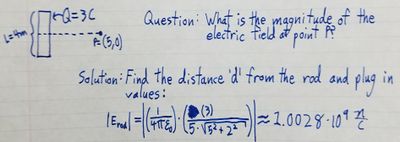
Middling
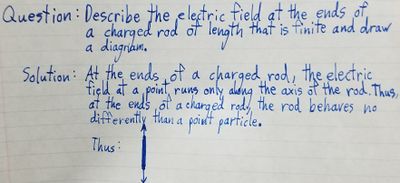
Difficult
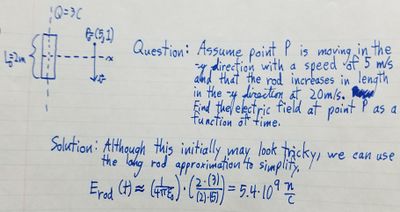
Connectedness
The following two DIY experiments are shown to better understand and visualize the physical consequences of electric fields.
Charged Rod and Aluminum Can
In our first example we set up an experiment using two charged rods placed to the left and right of an aluminum can, distanced by a length d. If one of the rods is positively charged and the other is negatively charged, what will the can do? Because the positively charged rod induces a negative charge on the left side of the can, creating an attractive force between the rod and the can, and the negatively charged rod induces an equal positive charge on the right side of the can, which creates an attractive force between the can and that rod, the net force on the can is zero. Thus the can will stay still. The setup is depicted in the image below.
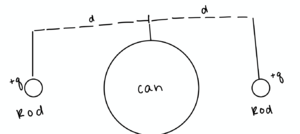
Next, lets consider a setup but with both rods having equal positive charge, as shown in the image below. What will the can do in this situation?
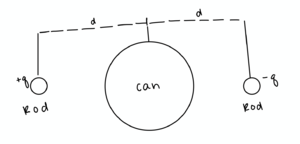
Again the can will also stay still, but this time it is because the polarization force between two objects is always attractive.
So in what scenario will the can move, and what time of movement will the can exhibit? Considering the first setup, imagine this time we initially touch the negatively charged rod and the can for a brief moment. Holding the rods at equal distance on either side of the can, the can will now roll toward the positively charged rod. This is because the can acquires a net negative charge after being touched, so it is then attracted to the positively charged rod.
Charged Rod and Pith Ball
Another DIY experiment to visualize the effects of an electric field are shown in the video embedded below, which depicts the interaction between an initially neutral pith ball hanging on a string from a stand, and a charged rod. Interaction between a Charged Rod and Pith Ball
History
Physicists and scientists make use of electric fields and charged objects all the time. Many times, we may need to know which objects are contributing how much charge in certain areas. Charged objects may attract or repel (depending on the signs of their charge), so we often need to know how objects will interact with each other based on their charges. The phenomenon of this interaction, or electric force between charged particles, was finally confirmed and stated as a law in 1785 by French physicist Charles-Augustin de Coulomb, hence "Coulomb's Law." A portrait of Coulomb is shown below.
The model of a uniformly charged rod can be applicable to situations where the rod is interacting with other charged objects, whether they are large or microscopic, such as charged particles, like protons or electrons, travelling in the rod's field.
See also
The equation for the electric field of a charged rod was derived from the equation for an electric field of a charged particle. See the article "Electric Field" for more information.
Further Reading
The page on electric fields: Electric Field
External Links
http://online.cctt.org/physicslab/content/phyapc/lessonnotes/Efields/EchargedRods.asp
http://dev.physicslab.org/Document.aspx?doctype=3&filename=Electrostatics_ContinuousChargedRod.xml
References
https://www.youtube.com/watch?v=BBWd0zUe0mI
(For the above reference, I chose to follow the textbook's method in not defining the charge distribution and assuming it was constant, though this was helpful in figuring out a better way to introduce it.)
Chabay and Sherwood: Matter and Interactions, Fourth Edition, Chapter 15
All figures created by author
